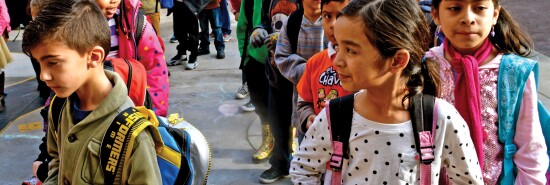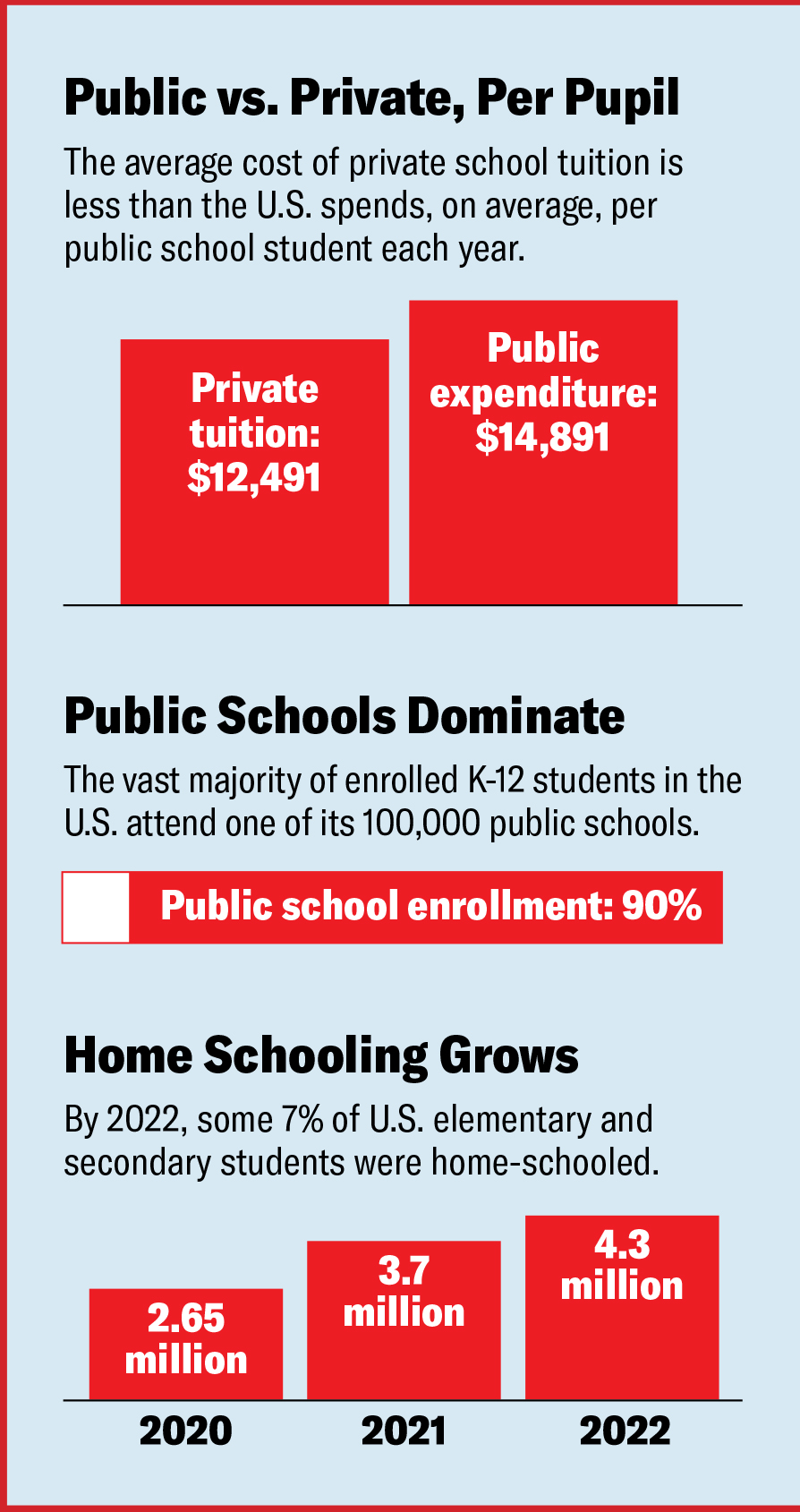
Where schooling stands: Public, private, and home schools by the numbers
Nicole Russell
The gains made by school choice advocates mean that more than at any time in recent memory, public schooling isn’t the only form of education parents can choose for their children. As home schooling has grown, especially post-pandemic, and voucher programs, or education savings accounts, slowly spread state by state, it’s a good time to take a look at the state of our nation’s K-12 education, system by system, heading into the new school year.

Private school
No matter the state of the economy, sending a child to private school isn’t a choice everyone can make. There are about 30,000 private schools in the United States, and about 10% of children in grades K-12 are enrolled in private schools right now. Although private school enrollment took a hit in 2019, down to 4.7 million students from 5.7 million in 2017, the Cato Institute found in its own survey that 55% of private schools had seen an increase in enrollment between the 2021-22 and 2022-23 school years.
SCHOOL CHOICE FOES TURN TO BALLOT REFERENDUMS AS STATES EXPAND VOUCHER PROGRAMS
Hawaii has the highest share of its K-12 students in private schools, 19%, with Washington, D.C., right behind at 18%, according to Private School Review. There’s a reason only 10% of America’s children attend private school, though, and that’s typically because of the cost.
These days, the cost of private school mirrors the cost of tuition for a four-year college degree a few years ago. The average private school tuition cost is approximately $12,491 per year, slightly less for elementary students and about $16,003 per year for high schoolers. Connecticut has the nation’s highest average private school tuition, coming in at a whopping $28,861. In South Dakota, parents can send their children to private schools for just under $4,000. In addition to tuition, parents will pay, on average, $3,700 per student in extra fees for items such as books, supplies, sports, and uniforms. There’s been about a 28% increase in private school tuition fees between 2007-08 to 2020-21.
The Cato Institute found that a bare majority of parents would prefer to send their children to private schools. Parents point to the personal attention children get, the rigorous education they receive, and the good reputation private schools tend to have.
Home school
Home schooling is now the fastest growing form of education in the U.S. thanks in part to overreaching mandates during the pandemic that closed schools, instituted remote learning, and let millions of parents in on just what their children were learning — or weren’t learning.
About 7% of students in America are now home-schooled. In 2020, there were up to 2.65 million home-schooled students. In 2021, that number rose to 3.7 million. By 2022, it was 4.3 million.
According to a 2023 study commissioned by Age of Learning, Indiana and Idaho are the best states for home-schooling in the U.S., based on access to school sports, whether the state laws governing home-schooling are welcoming to the practice, and the number of home-schoolers — the larger the home-schooling community, the more support parents will have and the more options students will have, especially for social interaction and group classes or activities. New Jersey is the least-regulated state for home schooling as far as registration and curriculum requirements, and Alaska has the most students enrolled in home school per capita in the U.S. in 2023. Home-schooling interest has increased the most in Connecticut, 128% since 2019.
Dr. Brian Ray, president of the National Home Education Research Institute, said the pandemic isn’t the only reason for the growing interest in home schooling. “First, it’s become much more totally socially acceptable. The adult peer pressure against home schooling is almost gone,” Ray said in an interview with the Washington Examiner. “Second, the research keeps affirming, over and over again, that children who are home-schooled on average do better academically, the same in terms of social or emotional development, and better in adulthood. Third factor, the more people home-school, the more they home-school.” In other words, they stick with it.
Public school
Although public schools are often criticized by conservatives, statistics show that 85% to 90% of children in the U.S. attend them. With more than 13,000 public school districts made up of about 100,000 schools, the public school system nationwide enrolls nearly 48 million K-12 students.
It’s no secret that, as a whole, the U.S. public education system is struggling. Students’ academic scores reflect this. In a 2018 study, the U.S. placed 11th out of 79 countries in science and worse in math. Math scores haven’t seen much improvement over the past two decades despite large increases in spending. In fact, the nation spends, on average, $14,891 per public school student per year, to the tune of $762 billion total.
The steady complaints about public schools range from lack of academic rigor to liberal political indoctrination of students in the classroom. Frustration with the status quo is what has led many states’ lawmakers to institute some kind of school choice — either vouchers or education savings accounts. As of this writing, 34 states, Washington, D.C., and Puerto Rico allow school choice in some limited or expanded form. The states include: Alabama, Arizona, Arkansas, Florida, Georgia, Illinois, Indiana, Iowa, Kansas, Kentucky, Louisiana, Maine, Maryland, Minnesota, Mississippi, Missouri, Montana, North Carolina, Nebraska, Nevada, New Hampshire, Idaho, Ohio, Oklahoma, Pennsylvania, Rhode Island, South Dakota, South Carolina, Tennessee, Utah, Vermont, Virginia, West Virginia, and Wisconsin.
The Texas legislature will go into special session soon to debate instituting a school choice program.
The bright side
One result of well-publicized struggles of the public education system has been increased parental involvement and interest in education. This is a boon for children and families.
In 2022, the New York-based organization 1776 Project PAC galvanized parents to get involved in their school boards and helped to endorse more than 100 school board candidates in states such as Florida, Texas, Virginia, and Pennsylvania. The organization focuses on helping elect people to school boards who “want to reform our public education system by promoting patriotism and pride in American history.”
Parents Defending Education also emerged from the pandemic and exists as a liaison between concerned parents and schools that might be indoctrinating their children.
“Did education always lean left? Yes, but it didn’t always feel like it’s a hot spot of leftist political activity. Now it’s come barreling in, and we’re trying to eradicate that. …We’re looking for a nonpolitical experience for students,” Erika Sanzi, director of outreach at PDE, told the Washington Examiner.
The organization encourages parents to report instances of indoctrination via discrimination, such as separating students by race or forcing students to admit they’re part of an “oppressed” class in an assignment. In response, PDE will sometimes alert the media, file a complaint with civil rights offices, or, in rare cases, litigate.
“One thing that’s hugely positive is that the level of parental engagement has exponentially increased,” Sanzi said. “Schools never expected scrutiny. They expected participation with bake-offs … not scrutiny over curriculum.”
Robert Pondiscio, a senior fellow at the American Enterprise Institute, also supports accountability in public education, particularly in the quest for a more uniform set of curricula. The current design of the system, he said, expects teachers to be both expert lesson developers and deliverers. “Curriculum should be more central to public education than it is,” Pondiscio told the Washington Examiner.
CLICK HERE TO READ MORE FROM THE WASHINGTON EXAMINER
A former teacher in the Bronx, Pondiscio is still gravely concerned about the learning loss students are navigating post-pandemic. Since public schools draw the majority of the nation’s children, the problem will affect everyone in the coming decades. That’s why, despite his strong support for school choice, Pondiscio exhorts conservatives not to give up on improving public education at the same time.
“It does concern me that a lot of our colleagues on the Right tend to view the problems with public education as an opportunity to promote choice,” Pondiscio said. “It’s a little bit shortsighted. We care about choice because we care about all American children.”
Nicole Russell is a journalist and mother of four who is the opinion columnist at the Fort Worth Star-Telegram. She previously lived outside Washington, D.C., and is a Minnesota native.
